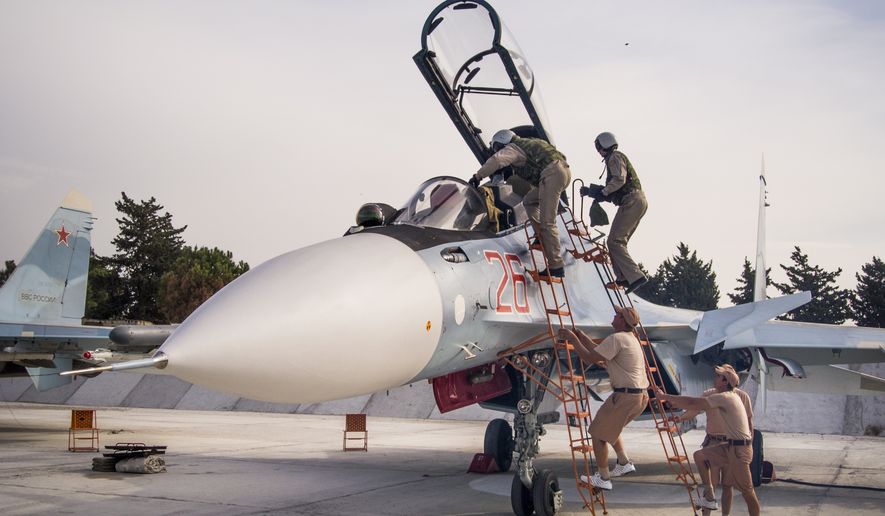Russia has been using the Syrian civil war to test some of its new weapons, as the West accuses Russian President Vladimir Putin of indiscriminate aerial bombardments that have killed many civilians.
Mr. Putin’s establishment of a burgeoning air base in northwestern Syria is permanent, says a pro-government journal in Moscow, adding that the war has allowed Russian pilots much-needed training hours.
Western powers follow a strict protocol in testing armaments in nonhostile environments before they are judged operational and sent to war.
Russia is looking at Syria not only as a show of its expeditionary prowess, but also as a proving ground for Mr. Putin’s military modernization programs, according to a firsthand analytical article in Expert Online, the Web version of an influential weekly magazine. Connected to Mr. Putin’s power base, it named him its Person of the Year in 2007. It bestowed the same honor on his foreign minister, Sergey Lavrov, the previous year.
The Expert magazine analysis paints an upbeat picture of Mr. Putin’s 6-month-old incursion into Syria to bolster the regime of President Bashar Assad, who stands accused of killing thousands of innocents via chemical weapons, airstrikes and artillery barrages.
“The Russian-Syrian coalition has no need to hurry,” Expert writes. “The air campaign is not expensive for Moscow, and it allows Russia to train pilots and to test the battle performance of different types of weapons. These benefits are in addition to the political gains and to the main goal, which is to eliminate Russian-speaking fighters in theaters far away from Russia’s borders.”
Expert is repeating one of Moscow’s justifications: In Syria, it is killing Russian-speaking foreign fighters who pose threats to Moscow.
“The joint military campaign of the Russian air force and Syrian troops seems to be [progressing] slowly but surely,” says the article, translated by the Middle East Media Research Institute.
MEMRI focuses on monitoring the communications of jihadis, especially the Islamic State terrorist group now controlling large sections of Syria and Iraq. MEMRI has begun to pay closer attention to the media surrounding Mr. Putin, given his foreign adventures and threats against Eastern Europe.
Expert magazine said Mr. Putin’s strategic goal is to recapture as much territory as possible for Mr. Assad, which would strengthen his hand in negotiating an end to the 5-year-old civil war.
Russia and the U.S. announced a partial cease-fire in Syria last week.
The Expert article says the Russian-Syrian alliance has taken back 217 villages and towns and 1,000 square miles of territory. Strategically, Mr. Putin has forever changed the balance of power in the Middle East.
“In addition, thanks to the new Russian air force base in the [Syrian city of] Latakia, Moscow has established a permanent presence in the region, controlling a very important logistic hub,” the article says. “This modern military base (equipped with Iskander and S-400 missiles) changes the military and political situation in Iraq, Iran, Israel, the U.S. and, of course, Turkey.”
New weapons field-tested
The Institute for the Study of War, a nonprofit think tank in Washington, reported this month that any cease-fire will not prevent Russia from continuing to bomb Aleppo, the rebel-held city in northwestern Syria, under the guise of killing terrorists.
Mr. Lavrov has argued that the area is festooned with Islamic terrorist groups, such as Jabhat al Nusra, that are not protected by the agreement.
“Russia and the Assad regime are still pursuing a victory in Aleppo despite a diplomatic agreement between the great powers,” the institute said. “Russian airstrikes will in fact likely continue to target a broad category of opposition groups that Russia accuses to be Jabhat al Nusra, including groups that receive U.S. support.”
Russia has established a no-fly zone in northern Syria aimed at preventing Turkey from striking Kurdish forces, some of whom are fighting the Islamic State and others opposing Ankara.
In November, Turkey shot down a Russian fighter jet it said had invaded its airspace.
Besides the war theater of Aleppo, Russia has launched airstrikes to aid the Syrian army and Lebanese Hezbollah, an Iran-backed militant group, as they fight rebels around Latakia’s coastal region. Meanwhile, government troops are going block by block in the capital of Damascus to kill the last remaining Islamists.
An independent aviation analyst told The Washington Times that the degree to which Russia is testing new weapons in Syria depends on the definition of “testing.” It may be a case of Russia introducing systems into combat for the first time.
“Much of their newer equipment deployed to Syria has not been used in live combat before, but tested to death on various test ranges in Russia, shooting live missiles and dropping live bombs,” said the analyst, who asked not to be identified because he handles sensitive data.
He said, for example, that Russia’s latest version of its Sukhoi-produced fighter bombers — the Su-34, which arrived in Syria — was tested for eight years before it was approved for full production.
“I would use the term ’first operational use’ or ’first combat use,’” the analyst said. “That is the only accurate term, and is commonly used by professionals. What you get with this kind of operational use is that you find bugs and gremlins that did not show up in testing, and you get to refine tactics and techniques.”
According to this source, among the new Russian warplanes in Syria are the Su-35S Flanker, the Su-34 Fullback, the Su-30SM Flanker and the Su-24M2 Fencer.
There are two new surface-to-air missiles, the S-400 SA-21 and the Buk-M2E SA-17 “Grizzly”; three new cruise missiles; and the KAB-500 satellite-guided bomb.
The U.S. military and human rights groups charge that Moscow is using “dumb” gravity bombs in the vast majority of its strikes. This has resulted in bombs hitting clinics, schools, refugee centers and residences, killing hundreds of innocents.
• Rowan Scarborough can be reached at rscarborough@washingtontimes.com.




Please read our comment policy before commenting.